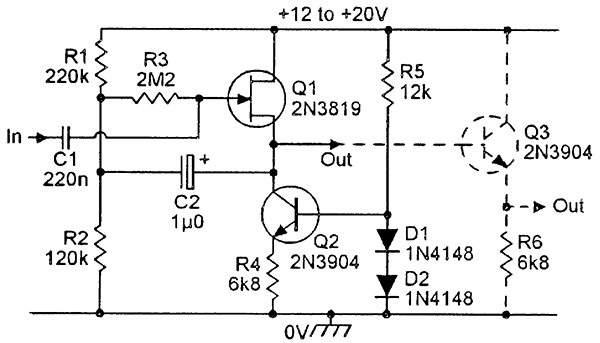The output Z of the source follower is assumed to be 1-2k (1/gm). The emitter-follower Z is roughly 1/hfe times the source Z. So, hfe being in the 100-500 range, that gives a range of 2-20 for the output Z. In fact probably higher since the FET is operated at very low current.warpie said:Thanks, that makes some more sense to meIs it too much to ask how do I go about calculating the output impedance (i.e how did you calculate the "few dozen ohms")?
This is true up to a point. The quiescent current in the FET being only 70uA, its limited capability to produce negative peaks restricts the RMS current at about 50uA. The resulting output capability at the output of the emitter-follower is hfe times this. Again assuming hfe to be 100-500, the output current is in the range 0.5mA-2.5mA.I would assume that the lower the R6 the higher the headroom but how do I choose the correct value.
Case1: hfe 100. Q3 quiescent current 0.7mA, R6=10k (assuming B+ at 15V and DC op point at 1/2 B+). Output load 2kohms (many mic inputs are closer to 1.5k). Resulting load 10k//2k=1.66k. 0.5mAac into 1.66k=> 0.8Vrms.
Case 2: hfe 500. Q3 quiescent current 3.5mA, R6=2.16k
Resulting load 2.16//2k=1.04k. 3.5mAac into 1.04k=> 3.6Vrms.
Now this calculation has more shortcuts and approximations than a congressman's speech, so you would be lucky if you approached these figures with less than 50% error.
In conclusion, there is a point where decreasing R6 increases so much the demand on the preceding stage that it becomes counteractive.



